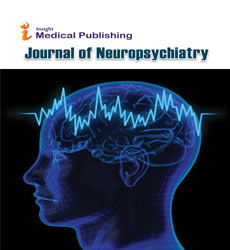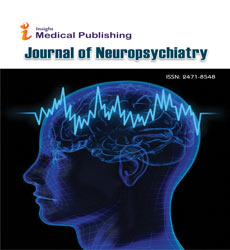Neuropsychiatry in Clinical Practice: The Challenge Of Diagnosing Behavioral Variant Frontotemporal Dementia
Flora Gossink,Everard Vijverberg, Yolande Pijnenburg and Annemiek Dols
DOI10.21767/2471-8548.10004
Flora Gossink1,2*, Everard Vijverberg2,3, Yolande Pijnenburg1,2 and Annemiek Dols1,2
1Department of Old Age Psychiatry, VU University Medical Center, Amsterdam, The Netherlands
2Alzheimer Centre and Department of Neurology, VU University Medical Center, Amsterdam Neuroscience, The Netherlands
3Department of Neurology, HagaZiekenhuis, The Hague, The Netherlands
- *Corresponding Author:
- Flora Gossink
Department of Old Age Psychiatry
VU University Medical Center
Amsterdam, The Netherlands
Tel: +3115618942050
E-mail: F.Gossink@ggzingeest.nl
Received date: January 01, 2018; Accepted date: January 10, 2018; Published date: January 20, 2018
Citation: Flora G, Everard V, Yolande P, Annemiek D. Neuropsychiatry in Clinical Practice: The Challenge of Diagnosing Behavioral Variant Frontotemporal Dementia. J Neuropsychiatry 2018, Vol. 2 No. 1: 4.. doi: 10.21767/2471-8548.10004
Copyright: © 2018 Flora G, et al. This is an open-access article distributed under the terms of the Creative Commons Attribution License, which permits unrestricted use, distribution, and reproduction in any medium, provided the original author and source are credited.
Abstract
The behavioral variant of Frontotemporal dementia (bvFTD) is an insidious neurodegenerative disease associated with progressive degeneration of the frontal lobes, anterior temporal lobes, or both [1]. Alterations in social cognition represent the core symptoms of bvFTD resulting in emotional disengagement and socially inappropriate responses or activities [2,3]. As is apparent in revised consortium criteria, additional neuropsychiatric symptoms including apathy and stereotypical and impulsive behavior are prominent in the clinical presentation [4]. Consequently, both neurodegenerative diseases and primary psychiatric disorders are crucial in the challenging differential diagnosis. The differentiation between bvFTD and Alzheimer’s disease (AD) has become easier by the use of biomarkers that are able to identify underlying AD pathology, such as the amyloid-β (Aβ) and tau [1,5]. However, to distinguish bvFTD from psychiatric disorders can still be difficult, particularly since biomarkers for bvFTD are less robust [6]. Previous studies indicated that as a result of symptomatic overlap between bvFTD and psychiatric disorders, bvFTD patients are clinically often mistaken for psychiatric patients and vice versa [7-10]. The current clinical criteria for bvFTD require that “if behavioral disturbance is better accounted for by a psychiatric diagnosis, a diagnosis of bvFTD has to be excluded” [4]. Despite clinical overlap, bvFTD patients do not often fulfill formal criteria for a psychiatric diagnosis, suggesting that it is valuable to apply formal criteria for psychiatric disorders [11]. Careful clinical phenotyping of overlapping symptoms can help to distinguish bvFTD from psychiatric disorders in clinical practice (Figure 1) [12,13]. Figure 1 Overlap and differentiation between bvFTD and psychiatric disorders in clinical practice. The value of different symptom rating scales and clinical tools has been proven useful in clinical practice in case of suspected bvFTD when a psychiatric disorder is also probable (Figure 2) [11,14,15]. Figure 2 Clinical hallmarks and supportive measuring instruments in the differential diagnosis bvFTD and psychiatric disorders. According to current criteria, the diagnostic certainty of bvFTD increases when Frontotemporal abnormalities are found on neuroimaging. In a large cohort of patients with late-onset behavioral changes, MRI had a sensitivity of 70% and a specificity of 93% for a bvFTD diagnosis [4]. The additional [18F]FDG-PET, when the MRI was inconclusive, had a sensitivity of 90% at the cost of a lower specificity (68%) [16]. [18F]FDG-PET is mainly useful when Frontotemporal hypo-metabolism is absent to exclude bvFTD diagnosis. The interpretation of neuroimaging results should especially be taken with caution in cases with a psychiatric differential diagnosis where [18F]FDG-PET is the only abnormal investigation and in cases with a genetic background where both MRI and [18F]FDG-PET can show a specific abnormalities [16-18]. Genetic screening especially for C9orf72 repeat expansion is emphasized [19,20]. particularly in cases with a remarkable (prolonged) disease course. In clinical practice, bvFTD has a broad differential diagnosis including both neurodegenerative diseases and primary psychiatric disorders. The current criteria for bvFTD have clearly improved diagnostics but differentiating bvFTD from psychiatric disorders remains difficult. The challenge for the next decade is finding specific biomarkers for bvFTD on the one hand, and optimizing the neuropsychiatric diagnosis of bvFTD on the other hand. To this end, patient care for suspected bvFTD patients would be largely improved in a setting where neurologists and psychiatrists work hand in hand, ideally applying a consensus set of clinical rating scales next to their clinical expertise.
Editorial
The behavioral variant of Frontotemporal dementia (bvFTD) is an insidious neurodegenerative disease associated with progressive degeneration of the frontal lobes, anterior temporal lobes, or both [1]. Alterations in social cognition represent the core symptoms of bvFTD resulting in emotional disengagement and socially inappropriate responses or activities [2,3]. As is apparent in revised consortium criteria, additional neuropsychiatric symptoms including apathy and stereotypical and impulsive behavior are prominent in the clinical presentation [4]. Consequently, both neurodegenerative diseases and primary psychiatric disorders are crucial in the challenging differential diagnosis.
The differentiation between bvFTD and Alzheimer’s disease (AD) has become easier by the use of biomarkers that are able to identify underlying AD pathology, such as the amyloid- β (A β) and tau [1,5]. However, to distinguish bvFTD from psychiatric disorders can still be difficult, particularly since biomarkers for bvFTD are less robust [6]. Previous studies indicated that as a result of symptomatic overlap between bvFTD and psychiatric disorders, bvFTD patients are clinically often mistaken for psychiatric patients and vice versa [7-10]. The current clinical criteria for bvFTD require that “if behavioral disturbance is better accounted for by a psychiatric diagnosis, a diagnosis of bvFTD has to be excluded” [4].
Despite clinical overlap, bvFTD patients do not often fulfill formal criteria for a psychiatric diagnosis, suggesting that it is valuable to apply formal criteria for psychiatric disorders [11]. Careful clinical phenotyping of overlapping symptoms can help to distinguish bvFTD from psychiatric disorders in clinical practice (Figure 1) [12,13].
The value of different symptom rating scales and clinical tools has been proven useful in clinical practice in case of suspected bvFTD when a psychiatric disorder is also probable (Figure 2) [11,14,15].
According to current criteria, the diagnostic certainty of bvFTD increases when Frontotemporal abnormalities are found on neuroimaging. In a large cohort of patients with lateonset behavioral changes, MRI had a sensitivity of 70% and a specificity of 93% for a bvFTD diagnosis [4]. The additional [18F]FDG-PET, when the MRI was inconclusive, had a sensitivity of 90% at the cost of a lower specificity (68%) [16]. [18F]FDG-PET is mainly useful when Frontotemporal hypometabolism is absent to exclude bvFTD diagnosis. The interpretation of neuroimaging results should especially be taken with caution in cases with a psychiatric differential diagnosis where [18F]FDG-PET is the only abnormal investigation and in cases with a genetic background where both MRI and [18F]FDG-PET can show a specific abnormalities [16-18]. Genetic screening especially for C9orf72 repeat expansion is emphasized [19,20]. particularly in cases with a remarkable (prolonged) disease course.
In clinical practice, bvFTD has a broad differential diagnosis including both neurodegenerative diseases and primary psychiatric disorders. The current criteria for bvFTD have clearly improved diagnostics but differentiating bvFTD from psychiatric disorders remains difficult. The challenge for the next decade is finding specific biomarkers for bvFTD on the one hand, and optimizing the neuropsychiatric diagnosis of bvFTD on the other hand. To this end, patient care for suspected bvFTD patients would be largely improved in a setting where neurologists and psychiatrists work hand in hand, ideally applying a consensus set of clinical rating scales next to their clinical expertise.
References
- Piguet O, Hornberger M, Mioshi E, Hodges JR (2010) Behavioural-variant frontotemporal dementia: diagnosis, clinical staging, and management. Lancet Neurol 10: 162-172.
- Ibanez A, Manes F (2012) Contextual social cognition and the behavioral variant of Frontotemporal dementia. Neurology 78: 1354-1362.
- Special lecture (2017) Social Cognition in Frontotemporal Dementia Proceedings: Special Lecture Neuropsychology Association of Japan 40th Annual Meeting. J Neuropsychol 33: 9-24.
- Rascovsky K, Hodges JR, Knopman D, Mendez MF, Kramer JH, et al. (2011) Sensitivity of revised diagnostic criteria for the behavioural variant of Frontotemporal dementia. Brain 134: 2456-2477.
- Mckhann GM, Knopman DS, Chertkow H, Hyman BT, Jack CR Jr, et al. (2011) The diagnosis of dementia due to Alzheimer's disease: recommendations from the National Institute on Aging-Alzheimer's Association workgroups on diagnostic guidelines for Alzheimer's disease. Alzheimers Dement 7: 263-269.
- Vijverberg EGB, Dols A, Krudop WA, Del Campo Milan M, Kerssens CJ, et al. (2017) Cerebrospinal fluid biomarker examination as a tool to discriminate behavioral variant Frontotemporal dementia from primary psychiatric disorders. Alzheimers Dement (Amst) 7: 99-106.
- Krudop WA, Dols A, Kerssens CJ, Eikelenboom P, Prins ND, et al. (2017) The Pitfall of Behavioral Variant Frontotemporal Dementia Mimics Despite Multidisciplinary Application of the FTDC Criteria. J Alzheimers Dis 60: 959-975.
- Woolley JD, Khan BK, Murthy NK, Miller BL, Rankin KP (2011) The diagnostic challenge of psychiatric symptoms in neurodegenerative disease: Rates of and risk factors for prior psychiatric diagnosis in patients with early neurodegenerative disease. J Clin Psychiatry 72: 126-133.
- Vijverberg EG, Dols A, Krudop WA, Peters A, Kerssens CJ, et al. (2016) Diagnostic accuracy of the Frontotemporal dementia consensus criteria in the late-onset frontal lobe syndrome. Dement Geriatr Cogn Disord 41: 210-219.
- Krudop W, Kerssens CJ, Dols A, Prins ND, Moller C, et al. (2014) Building a new paradigm for the early recognition of behavioral variant Frontotemporal dementia: Late Onset Frontal Lobe Syndrome study. Am J Geriatr Psychiatry 22: 735-740.
- Gossink FT, Dols A, Krudop WA, Sikkes SA, Kerssens CJ, et al. (2016) Formal Psychiatric Disorders are not Overrepresented in Behavioral Variant Frontotemporal Dementia. J Alzheimers Dis 51: 1249-1256.
- Gossink FT, Vijverberg EGB, Krudop W, Scheltens P, Stek ML, et al. (2017) Psychosis in behavioral variant Frontotemporal dementia. Neuropsychiatr Dis Treat 13: 1099-1106.
- Dols A, Van-Liempt S, Gossink F, Krudop WA, Sikkes S, et al. (2016) Identifying Specific Clinical Symptoms of Behavioral Variant Frontotemporal Dementia Versus Differential Psychiatric Disorders in Patients Presenting With a Late-Onset Frontal Lobe Syndrome. J Clin Psychiatry 77: 1391-1395.
- Vijverberg EGB, Gossink F, Krudop W, Sikkes S, Kerssens C et al. (2017) The Diagnostic Challenge of the Late-Onset Frontal Lobe Syndrome. J Clin Psychiatry.
- Gossink FT, Schouws SKW (2017) Social cognition differentiates behavioral variant frontotemporal dementia from other neurodegenerative diseases and psychiatric disorders. Am J Geriatr Psychiatry.
- Vijverberg EGB, Wattjes MP, Dols A, Krudop WA, Moller C et al. (2016) Diagnostic Accuracy of MRI and Additional [ 18 F]FDG-PET for Behavioral Variant Frontotemporal Dementia in Patients with Late Onset Behavioral Changes. J Alzheimers Dis 53: 1287-1297.
- Steketee RME, Meijboom R, Bron EE, Osse RJ, De-Koning I et al. (2016) Structural and functional brain abnormalities place phenocopy Frontotemporal dementia (FTD) in the FTD spectrum. NeuroImage Clin 11: 595-605.
- Crossley NA, Scott J, Ellison-Wright I, Mechelli A (2015) Neuroimaging distinction between neurological and psychiatric disorders. Br J Psychiatry 207: 429-434.
- Kertesz A, Cyn-Ang L, Jesso S, Mac-Kinley J, Baker M, et al. (2013) Psychosis and Hallucinations in FTD with C9ORF72 mutation: A detailed clinical cohort. Cogn Behav Neurol 26: 146-154.
- Khan BK, Yokoyama JS, Takada LT, Sha SJ, Rutherford NJ, et al. (2012) Atypical, slowly progressive behavioural variant frontotemporal dementia associated with C9ORF72 hexanucleotide expansion. J Neurol Neurosurg Psychiatry 83: 358-364.

Open Access Journals
- Aquaculture & Veterinary Science
- Chemistry & Chemical Sciences
- Clinical Sciences
- Engineering
- General Science
- Genetics & Molecular Biology
- Health Care & Nursing
- Immunology & Microbiology
- Materials Science
- Mathematics & Physics
- Medical Sciences
- Neurology & Psychiatry
- Oncology & Cancer Science
- Pharmaceutical Sciences


